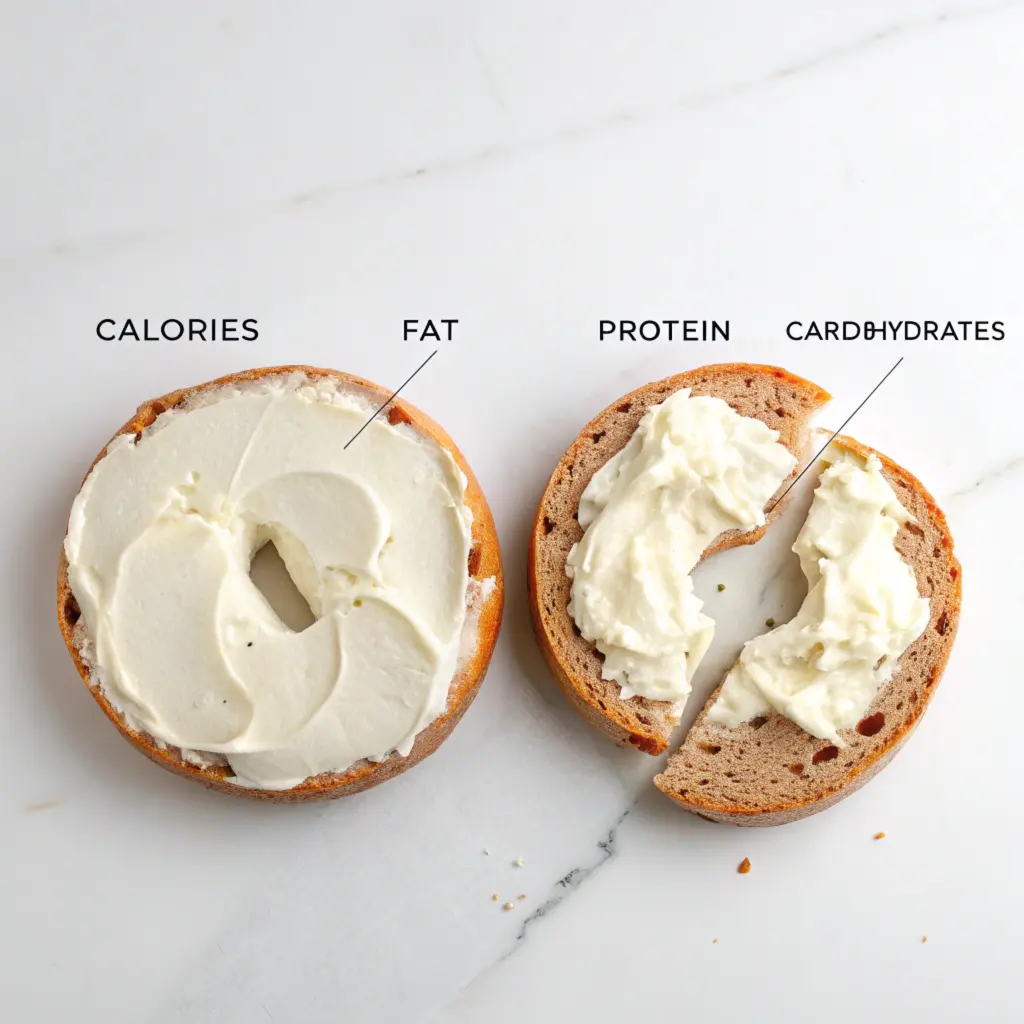Is a bagel and cream cheese healthy? It’s a question that often comes to mind when you’re looking for a quick breakfast or snack option. Bagels and cream cheese are a beloved duo, offering a comforting mix of textures and flavors. However, with growing awareness about nutrition and balanced diets, many wonder whether this classic pairing is a friend or foe to our health goals.
In this article, we’ll dive into the nutritional details, health benefits, and potential downsides of bagels and cream cheese. Along the way, you’ll discover how to make smarter choices, find healthier alternatives, and understand where this popular combination fits into a balanced lifestyle. Let’s get started!
Understanding the Health Implications of Bagels with Cream Cheese
Popularity of Bagels and Cream Cheese
Bagels and cream cheese have carved a special spot in breakfast culture, especially in urban areas. From bustling cafes to cozy home kitchens, they’re a go-to meal cherished for their simplicity and versatility. However, their appeal isn’t limited to convenience—there’s also a sense of nostalgia that makes this duo irresistible.
Whether it’s a quick bite before rushing off to work or a leisurely treat as part of a weekend brunch, this combination provides a satisfying and comforting start to the day. It’s no wonder bagels and cream cheese have remained a beloved breakfast staple across generations.
If you’re intrigued by garlic cream cheese, check out our ultimate recipe and guide for Garlic Cream Cheese Bagels.
Nutritional Profile of Bagels

Caloric Content
Bagels are dense, and their calorie count reflects that. A standard plain bagel can have between 250–300 calories, which is quite significant for a single piece of bread. Pair it with cream cheese, and you’re adding even more to your plate.
Macronutrient Breakdown
Bagels are primarily made from refined flour, making them high in carbohydrates. A single bagel contains around 50–60 grams of carbs, with only a small amount of protein (about 9–11 grams) and minimal fat.
Fiber and Micronutrients
If you’re opting for a plain bagel, the fiber content is often lacking. Whole-grain options fare better, with more dietary fiber that supports digestion and helps regulate blood sugar. However, bagels aren’t known for being rich in vitamins or minerals unless fortified.
To better understand whether bagels and cream cheese are healthy, examining the nutritional profile of bagels is essential. You can find detailed insights about the nutritional profile of bagels here.
Nutritional Profile of Cream Cheese
| Nutrient | Plain Bagel (100g) | Cream Cheese (2 tbsp) | Total (1 serving) |
|---|---|---|---|
| Calories | 270 | 100 | 370 |
| Carbohydrates (g) | 54 | 1 | 55 |
| Protein (g) | 9 | 2 | 11 |
| Fat (g) | 1 | 10 | 11 |
| Saturated Fat (g) | 0.2 | 5 | 5.2 |
| Fiber (g) | 2 | 0 | 2 |
| Calcium (mg) | 20 | 28 | 48 |
| Sodium (mg) | 420 | 90 | 510 |
Caloric Content
A two-tablespoon serving of cream cheese adds about 100 calories to your meal. While it’s not excessive, the combination with a bagel creates a calorie-dense snack or meal.
Macronutrient Breakdown
Cream cheese is predominantly fat, with saturated fats making up a significant portion. There’s a small amount of protein (about 2 grams per serving) and almost no carbohydrates.
Vitamins and Minerals
Cream cheese provides small amounts of calcium and vitamin A, but it’s not a major source of nutrients. If you’re looking for a health boost, this isn’t the place to find it.
Potential Health Benefits
Source of Energy
When life gets hectic, bagels with cream cheese can be a reliable source of energy to fuel your day. Bagels are rich in carbohydrates, the body’s primary energy source, which makes them a great option before a busy morning. Cream cheese, though higher in fat, adds a bit of staying power to keep you feeling fuller for longer. Together, this pairing provides the quick and sustained energy that active individuals often seek.
Contribution to Daily Nutrient Intake
Although they’re often seen as indulgent, bagels and cream cheese can contribute to your daily nutrient intake. Bagels made with whole grains contain fiber, iron, and B vitamins, while cream cheese, in moderation, supplies calcium and vitamin A. The key lies in choosing the right ingredients and toppings to maximize nutritional benefits without overloading on empty calories.
Health Risks and Concerns
High Caloric Density
Despite their simplicity, bagels with cream cheese can be calorie-dense. A standard bagel alone often contains around 250–300 calories, and adding cream cheese can tack on an extra 100–150 calories per serving. If you’re not careful with portion sizes, it’s easy for this breakfast staple to push you over your daily caloric needs, especially if paired with other high-calorie toppings.
Saturated Fat Content
Cream cheese is undeniably creamy and flavorful, but it comes with a notable downside: high saturated fat content. Consuming too much saturated fat can contribute to increased cholesterol levels, which may raise the risk of heart-related issues over time. It’s important to use cream cheese sparingly or opt for lower-fat alternatives to reduce this risk while still enjoying the creamy texture you love.
Impact on Blood Sugar Levels
Traditional bagels, particularly those made with refined white flour, have a high glycemic index (GI). This means they can cause rapid spikes in blood sugar levels, followed by a sharp crash that often leaves you feeling tired and hungry soon after eating. For individuals managing diabetes or aiming to maintain stable energy levels throughout the day, this is a critical concern.
To help mitigate these effects, consider pairing your bagel with protein-rich toppings like smoked salmon, avocado, or eggs. These additions can slow digestion and moderate blood sugar fluctuations, making your meal more balanced and satisfying. Opting for whole-grain or lower-carb bagels can also help reduce the glycemic impact while adding more nutrients and fiber to your diet.
Bagels and Cream Cheese in a Balanced Diet
Portion Control
Portion control is essential when incorporating bagels and cream cheese into your diet. Opt for smaller bagels, or consider eating only half at a time, to keep your calorie and carbohydrate intake in check. Measuring your cream cheese serving—aiming for about one to two tablespoons—can also help prevent overindulgence while still satisfying your taste buds.
Frequency of Consumption
Eating bagels with cream cheese every day might not align with health-conscious goals, but enjoying them occasionally as part of a balanced diet is perfectly fine. Pair them with nutrient-dense foods, like fresh fruits or vegetables, to create a more rounded meal. This approach allows you to savor the foods you love without sacrificing your overall wellness.
Potential Health Benefits of Bagels and Cream Cheese
Source of Energy
Bagels are rich in carbohydrates, making them a quick and reliable source of energy. Whether you’re rushing to a meeting or preparing for a workout, this carb-heavy breakfast can fuel your body. However, pairing it with cream cheese—a dairy-based product rich in fats—helps to slow digestion slightly, keeping you full for longer.
Contribution to Daily Nutrient Intake
Depending on the type of bagel, you can receive varying amounts of dietary fiber, iron, and B vitamins. Whole-grain bagels, for instance, contribute to your daily fiber needs, supporting digestion and heart health. Meanwhile, cream cheese offers a dose of calcium and vitamin A, which are essential for strong bones and healthy vision.
Health Risks and Concerns
High Caloric Density
Is a bagel and cream cheese healthy? One of the main concerns lies in its calorie content. Bagels and cream cheese can be calorie-dense, particularly if you opt for large bagels with a generous spread. A single serving can quickly surpass 400–500 calories, which is substantial for a meal or snack. Without proper portion control, regularly consuming this combination could lead to unintended weight gain, especially if paired with a sedentary lifestyle.
Saturated Fat Content
Cream cheese, a key component of this duo, often contains a significant amount of saturated fat. Consuming too much saturated fat may contribute to higher cholesterol levels, which are a known risk factor for cardiovascular issues. To enjoy bagels and cream cheese while maintaining heart health, it’s important to monitor your intake and consider alternatives such as reduced-fat cream cheese or plant-based options.
Impact on Blood Sugar Levels
Refined white bagels have a notoriously high glycemic index, meaning they can cause rapid spikes in blood sugar followed by sharp drops. This blood sugar rollercoaster can leave you feeling tired or hungry sooner than you’d like. For people with diabetes or insulin resistance, such fluctuations can be particularly problematic. Opting for whole-grain or lower-carb bagels can help stabilize blood sugar levels and provide more sustained energy.
Bagels and Cream Cheese in a Balanced Diet
Portion Control
Is a bagel and cream cheese healthy? The answer often hinges on portion control. Moderation is the name of the game. Opting for smaller bagels or halving a standard-sized one can help you enjoy this classic breakfast without overindulging. Likewise, applying a thin layer of cream cheese instead of piling it on can significantly cut back on unnecessary calories and saturated fat, making this indulgence more balanced.
Frequency of Consumption
Enjoying bagels and cream cheese occasionally is perfectly fine, but relying on them daily might not be the best choice for maintaining overall health. To keep your meals nutritionally diverse, consider balancing your diet with fruits, vegetables, lean proteins, and whole grains. This approach ensures you’re meeting your daily nutritional needs without overloading on calories or less beneficial nutrients.
Healthier Bagel Options
Whole Grain Bagels

Swapping out refined white bagels for whole-grain alternatives can be a real game-changer when asking, is a bagel and cream cheese healthy? Whole grains are packed with fiber, which supports healthy digestion and helps maintain stable blood sugar levels—an essential consideration for people managing energy fluctuations or diabetes.
Additionally, whole-grain bagels are more nutrient-dense than their refined counterparts. They deliver essential vitamins and minerals such as magnesium, iron, and B vitamins, all of which play critical roles in energy production, bone health, and overall wellness. Choosing whole-grain bagels is a small change that can help make bagels and cream cheese a healthier option for your meals.
Alternative Flours
Experimenting with bagels made from almond flour, chickpea flour, or oat flour can reduce the glycemic load and increase protein content. These options cater to individuals following low-carb or gluten-free diets and offer a unique twist on traditional bagels.
Healthier Cream Cheese Alternatives
Reduced-Fat Cream Cheese
For those wondering, is a bagel and cream cheese healthy, choosing reduced-fat cream cheese can be a step in the right direction. It offers the same creamy texture you love but with fewer calories and less saturated fat. This makes it a suitable option for individuals looking to manage their cholesterol levels or reduce their overall fat intake.
While reduced-fat cream cheese might lack some of the richness found in full-fat versions, it’s a smart and satisfying compromise for health-conscious eaters. Pair it with whole-grain bagels and nutritious toppings to create a balanced and delicious meal.
Plant-Based Spreads
Dairy-free spreads made from cashews, almonds, or tofu are becoming increasingly popular. These options are lower in saturated fat, cater to lactose-intolerant individuals, and often provide additional nutrients like healthy fats and protein.
Nutritious Toppings and Additions
Fresh Vegetables
Adding a layer of sliced tomatoes, cucumbers, or spinach not only boosts the flavor of your bagel but also increases your intake of vitamins and minerals. These veggies are low in calories and rich in antioxidants, making your meal more nutritious.
Lean Proteins
Incorporating protein-rich toppings like smoked salmon, grilled chicken, or boiled eggs can make your bagel more satisfying. Protein helps with muscle repair and keeps hunger at bay for longer periods.
Healthy Fats
Avocado slices or a drizzle of olive oil are excellent choices for adding healthy fats to your bagel. These fats support heart health and improve the absorption of fat-soluble vitamins found in other toppings.
Bagels and Cream Cheese for Specific Diets
Low-Carb Diets
Bagels, typically high in carbohydrates, may not be ideal for individuals on low-carb diets like keto. However, low-carb bagels made from almond or coconut flour can provide a satisfying alternative. Pair these with cream cheese or avocado for a meal that keeps you in line with your carb goals.
Gluten-Free Diets
For those with celiac disease or gluten intolerance, traditional bagels are off-limits due to their wheat-based composition. Thankfully, gluten-free bagels made from rice flour, sorghum, or chickpea flour offer safe and tasty options. Always ensure the cream cheese is free of cross-contamination for a completely gluten-free meal.
Lactose Intolerance
Cream cheese can be problematic for those who are lactose intolerant, as it contains dairy. Luckily, many brands now offer lactose-free cream cheese or plant-based alternatives made from cashews or soy. Pairing these with a gluten-free or low-carb bagel ensures a gut-friendly breakfast for sensitive stomachs.
Alternative Breakfast Options
High-Protein Choices
If you’re looking to start your day with something more filling, you might want to consider high-protein breakfasts. Options like Greek yogurt topped with nuts, scrambled eggs, or a smoothie blended with protein powder can be excellent choices. Not only do these meals keep hunger at bay, but they also provide long-lasting energy to fuel your morning.
In addition to curbing hunger, high-protein breakfasts support muscle repair and growth, making them particularly beneficial if you lead an active lifestyle. Furthermore, these options are versatile and easy to customize with your favorite ingredients, ensuring that your breakfast is both nutritious and enjoyable.
Low-Glycemic Index Foods
For a slower and steadier release of energy, you should consider breakfasts with a low glycemic index. Options like overnight oats with fresh fruit, chia pudding, or a slice of whole-grain toast with almond butter are excellent choices. Not only do these foods help maintain stable blood sugar levels, but they also reduce the likelihood of a mid-morning energy slump. Moreover, incorporating these meals into your routine can promote long-lasting energy throughout the day, which is especially helpful if you have a busy schedule.
By choosing low-glycemic index options, you’re not just avoiding blood sugar spikes; you’re also supporting better concentration and reducing hunger pangs later in the morning. In addition, these alternatives are easy to prepare and can be customized with your favorite healthy toppings, making them both practical and delicious.

FAQs About Bagels and Cream Cheese
Are bagels and cream cheese suitable for weight loss?
Bagels and cream cheese can fit into a weight loss plan, but moderation is key. A standard bagel with cream cheese is calorie-dense, often ranging from 300 to 500 calories per serving. Opting for smaller portions, whole-grain bagels, and reduced-fat or plant-based cream cheese can help reduce calorie intake. Adding fresh veggies or lean proteins can also enhance the nutritional value while keeping you full longer.
How many calories are in a bagel with cream cheese?
The calorie content varies depending on the size of the bagel and the amount of cream cheese used. A medium-sized plain bagel typically contains around 250–300 calories, while two tablespoons of regular cream cheese add about 100 calories. Together, this combination ranges between 350–400 calories. Be mindful of larger bagels or generous spreads, which can push the count even higher.
For a detailed breakdown of calorie counts for different bagel and cream cheese options, visit our guide on How Many Calories in a Bagel with Cream Cheese.
Can diabetics eat bagels and cream cheese?
Diabetics can enjoy bagels and cream cheese, but choosing the right type of bagel and portion size is crucial. Whole-grain or low-carb bagels are better options as they have a lower glycemic index, which helps maintain stable blood sugar levels. Pairing these with a thin layer of cream cheese or a plant-based alternative ensures a balanced meal without excessive carbs or fats.
For a more detailed guide, check out our article on Can Diabetics Eat Bagels and Cream Cheese?.
What is good on a bagel with cream cheese?
Cream cheese pairs beautifully with a variety of toppings that enhance both flavor and nutrition. Popular additions include smoked salmon, sliced tomatoes, cucumbers, avocado, or fresh herbs like dill. For a sweet twist, try a thin layer of cream cheese topped with sliced strawberries, a drizzle of honey, or a sprinkle of cinnamon.
For even more ideas and inspiration, visit our detailed guide on What Is Good on a Bagel with Cream Cheese.
Final Thoughts on Bagels and Cream Cheese
Is a bagel and cream cheese healthy? It can be, depending on how you incorporate it into your diet. Bagels and cream cheese can be a delicious and satisfying choice for breakfast or a snack, but their place in a healthy diet depends on how they are prepared and consumed. By opting for whole-grain bagels, practicing portion control, and exploring healthier cream cheese alternatives, you can enjoy this classic combo without compromising your health goals.
Is a bagel and cream cheese healthy? While they’re not the perfect food for every diet, thoughtful choices can make them a smart, occasional indulgence. Adding nutritious toppings like fresh vegetables, lean proteins, or healthy fats can elevate their nutritional value. Pairing bagels and cream cheese with other balanced meals ensures you’re getting a well-rounded diet.
Moderation and mindful eating are key to making this classic combination work within your lifestyle. Whether you’re counting calories, managing blood sugar, or just looking for a quick and satisfying breakfast option, bagels and cream cheese can fit into your plan with a little creativity and care.

